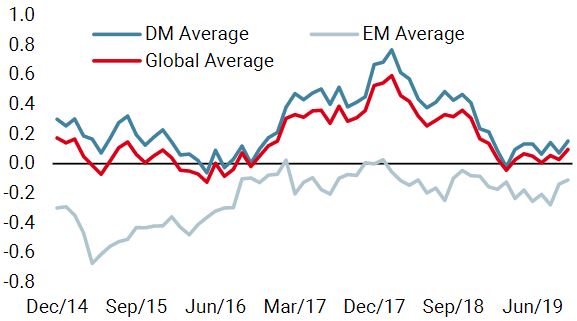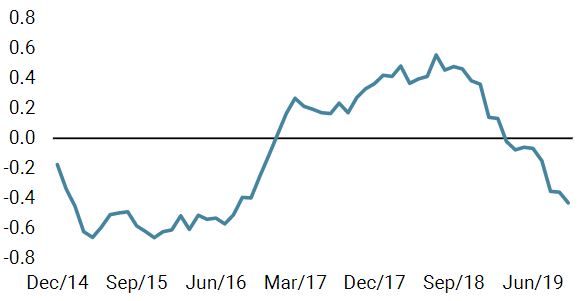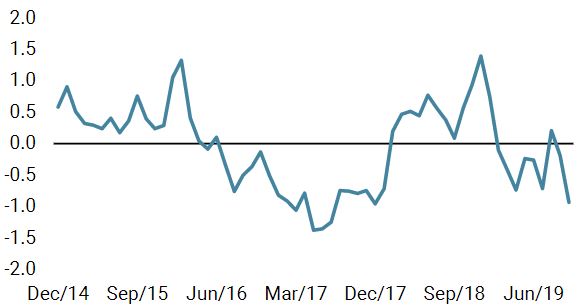Over the last few weeks, many of the risks that have been weighing on investors’ minds, including our own, have shown signs of moderating. A combination of resilient growth, monetary and fiscal policy, and a de-escalation of geopolitical tensions have calmed these headwinds, even if they may not all be tailwinds quite yet. At the same time, investors seem to remain defensively positioned, creating fertile ground for risky assets to outperform should the tailwinds materialise. While we do not believe the risks have dissipated entirely yet, we do believe the risk-reward favours holding risky assets and harvesting carry in investors’ pursuit of happiness. We have been communicating for some months now that global macro conditions are modestly supportive for risky assets. Since April of this year, our global Growth Nowcaster has remained steady at around potential levels, indicating that in aggregate the global economy is growing at a decent rate. This rate of growth does not eat into capacity constraints or increase slack in the economy, and is therefore a favourable environment for growth-oriented assets. In previous periods when our Growth Nowcaster was hovering around potential, global equities rose 0.9% on average (in total return terms) over the following month and posted positive returns in 62% of those months. Unsurprisingly, this is in line with their long-term behaviour (0.8% total return with 63% of the months positive). Importantly, there is a recent pickup in growth evident in both developed and emerging economies and our Growth Nowcaster diffusion index – which measures how much data is improving versus declining – points to upward growth momentum. The weakest components recently have been the “soft data,” or surveys such as purchasing manager indices that are susceptible to dour sentiment due to uncertainty. These are also the first components to shift when uncertainty is reduced. Interestingly, when examining the “hard data,” the picture is more positive. At the end of 2018 and into early 2019, the data suggested the impact from trade uncertainty was flowing through to the real economy, with various measures of global trade worsening. The turn in global monetary policy from tightening to easing has worked reasonably well since then, as it appears to have largely offset the slowdown, though with a lag. Stimulation measures on the part of Chinese policymakers have also helped to support the domestic economy, which is the largest contributor to global growth. The result of this confluence of monetary and fiscal policy has been resilient consumption and supportive financial conditions for the global economy, not the recession some had feared just a few weeks ago. This past week saw the ECB confirm its accommodative policy stance as Mario Draghi’s tenure as President of the ECB comes to an end. While taking over the reins of a globally critical central bank can lead to a change of mind (e.g. Jerome Powell), Christine Lagarde is expected to continue the ECB’s current support when she takes over as President next month. In the US, we expect the Fed to cut interest rates by another 25bps this week when the FOMC meets. The cut is well-priced by the market (90% likelihood) and Fed speakers have given no indication they will not cut, although forthcoming forward guidance could be interpreted as hawkish by the market if it shifts from an accommodative tone to a more patient, data-driven one. Nonetheless, market consensus seems to be coalescing around this week’s probable cut being the last of the “mid-cycle adjustments,” with the odds of additional cuts after this week fading. Thus, while monetary policy many not be the strong tailwind it has been for most of this year, it is also unlikely to turn into a headwind in the near term, as any tightening would require clear signals of a global economic recovery and strong reflation. Moreover, the market does not seem to be overly optimistic about additional monetary support. A key reason why policymakers and investors see less need for monetary support is the more positive picture for global trade. In addition to the efficacy of steps already taken by central banks, recent weeks have seen a thawing of relations between the US and China. To be clear, we expect trade uncertainty and broad tension between the world’s two largest economies to continue for some time. However, currently both sides are showing a willingness to make a deal, even if it is unlikely to be a grand bargain. Such an event would be positive for risky assets, as it would reduce to a degree one of the primary sources of uncertainty of the last two years. One other long-standing source of uncertainty also looks to be closing in on a resolution: Brexit. Last week, the UK Parliament signalled its willingness to get a deal done when it voted for the withdrawal agreement, though the timing of a needed extension has yet to be resolved. Nonetheless, the possibility of a no-deal Brexit or prolonged uncertainty has become much less likely.“Pursuit of Happiness” – Kid Cudi featuring MGMT, 2010
What’s Next?
Growth Has Shown Resilience and Benefited from Policy Support
Monetary Policy is Unlikely to be a Headwind for Some Time
Geopolitical Uncertainty Shows Signs of Ebbing

An environment such as the current one, with stable growth, supportive monetary policy and declining uncertainty is fertile ground for risky assets. Investors still seem to be positioned cautiously, with hedging assets and downside protection bid up, suggesting that if there were a market rally, it would be supported by investors shifting back into growth-oriented assets. Collecting carry in this environment is also attractive, as current defensive positioning in the market should keep sell-offs relatively muted. Nonetheless, we are not so naïve as to think that all risks are properly priced by the market, but we prefer to exploit any such mispricing via optional structures or opportunistic trades as our central scenario remains positive.The Pain Trade Remains to the Upside

Pursuit of Happiness

Our medium-term view is currently more constructive, as we are still overweight growth assets and underweight real assets. Given the current cost of hedging, we are using forex based strategies exposures to hedge ourselves against adverse market conditions. Over the month of October, the Multi Asset Risk Targeted Strategy is flat versus a 2.2% return for the MSCI AC World Index and a -0.5% return for the Barclays Global Aggregate (USD hedged). Year-to-date, the Multi Asset Risk Targeted Strategy has returned 10.2% versus 18.8% for the MSCI AC World index, while the Barclays Global Aggregate (USD hedged) index is up 8.2%. * The Multi Asset Risk Targeted Strategy performance is shown in USD net of fees for the representative account of the Multi Asset Risk Targeted (Medium) USD Composite and reflects the deduction of advisory fees and brokerage commission and the reinvestment of all dividends and earnings. Past performance is not indicative of future performance. This information is presented as supplemental information only and complements the GIPS compliant presentation provided on the following page.Strategy Behaviour
Performance Review
Unigestion Nowcasting
World Growth Nowcaster

World Inflation Nowcaster

Market Stress Nowcaster

Weekly Change
- Our world Growth Nowcaster remained unchanged this week, as both emerging and developed economies showed further signs of stabilisation.
- Our world Inflation Nowcaster decreased again this week across the board.
- Market stress decreased, driven by liquidity and volatility.
Sources: Unigestion. Bloomberg, as of 28 October 2019.
Important Information
Past performance is no guide to the future, the value of investments can fall as well as rise, there is no guarantee that your initial investment will be returned. This document has been prepared for your information only and must not be distributed, published, reproduced or disclosed by recipients to any other person. This is a promotional statement of our investment philosophy and services only in relation to the subject matter of this presentation. It constitutes neither investment advice nor recommendation. This document represents no offer, solicitation or suggestion of suitability to subscribe in the investment vehicles it refers to. Please contact your professional adviser/consultant before making an investment decision. Where possible we aim to disclose the material risks pertinent to this document, and as such these should be noted on the individual document pages. Please contact Unigestion for a complete list of all the applicable risks. Some of the investment strategies described or alluded to herein may be construed as high risk and not readily realisable investments, which may experience substantial and sudden losses including total loss of investment. These are not suitable for all types of investors. To the extent that this report contains statements about the future, such statements are forward-looking and subject to a number of risks and uncertainties, including, but not limited to, the impact of competitive products, market acceptance risks and other risks. As such, forward looking statements should not be relied upon for future returns. Data and graphical information herein are for information only and may have been derived from third party sources. Unigestion takes reasonable steps to verify, but does not guarantee, the accuracy and completeness of this information. As a result, no representation or warranty, expressed or implied, is or will be made by Unigestion in this respect and no responsibility or liability is or will be accepted. All information provided here is subject to change without notice. It should only be considered current as of the date of publication without regard to the date on which you may access the information. Rates of exchange may cause the value of investments to go up or down. An investment with Unigestion, like all investments, contains risks, including total loss for the investor.
This information is issued by Unigestion (UK) Ltd (“Unigestion”), which is authorised and regulated by the UK Financial Conduct Authority (“FCA”). Unigestion is also registered as an investment adviser with the U.S. Securities and Exchange Commission (“SEC”). This information is intended only for professional clients, institutional clients and eligible counterparties, as defined by the FCA, and qualified purchasers as defined by the SEC and has therefore not been adapted to retail clients.
Unigestion Multi Asset Risk-Targeted (USD): 31 December 2014 to 30 June 2019
| Year | Composite Return Gross of Fees |
Composite Net Return | Benchmark Return | Number of Accounts | Internal Dispersion | Composite 3-Yr Std Dev | Benchmark 3-Yr Std Dev | Composite AUM (M) | Firm AUM (M) |
| 2015 | -1.61% | -2.80% | – | 1 | – | – | – | 127.24 | 15,550.31 |
| 2016 | 5.05% | 3.79% | – | 1 | – | – | – | 129.66 | 18,144.46 |
| 2017 | 11.16% | 9.82% | – | 1 | – | – | – | 169.51 | 22,340.80 |
| 2018 | -2.91% | -4.08% | – | 1 | – | – | – | 286.93 | 21,403.49 |
| 20191 | 7.45% | 6.80% | – | 1 | – | – | – | 364.46 | 21,692.55 |
1: This year is incomplete, it stops in June.
Special Disclosure: For presentations prior to 31.03.2018 the strategy was measured against the LIBOR 3M USD + 4%. Beginning April 2018 the firm determined that the benchmark did not accurately reflect the strategy mandate and the benchmark was removed. Definition of the Firm: For the purposes of applying the GIPS Standards, the firm is defined as Unigestion. Unigestion is responsible for managing assets on the behalf of institutional investors. Unigestion invests in several strategies for institutional clients: Equities, Hedge Funds, Private Assets and the solutions designed for the clients of our Cross Asset Solution department. The GIPS firm definition excludes the Fixed Income Strategy Funds, which started in January 2001 and closed in April 2008, and the accounts managed for private clients. Unigestion defines the private clients as High Net Worth Families and Individual investors. Policies: Unigestion policies for valuing portfolios, calculating performance, and preparing compliant presentations are available upon request. Composite Description: The Multi Risk Targeted (Medium) composite was defined on 15 December 2014. It consists of accounts which aim to deliver consistent smooth returns of cash + 5% gross of fees across all market conditions over a 3-year rolling period. It seeks to achieve this by capturing the upside during bull markets while protecting capital during market downturns. Benchmark: Because the composites strategy is absolute return and investments are permitted in all asset classes, no benchmark can reflect this strategy accurately. Fees: Returns are presented gross of management fees, administrative fees but net of all trading costs and withholding taxes. The maximum management fee schedule is 1.2% per annum. Net returns are net of model fees and are derived by deducting the highest applicable fee rate in effect for the respective time period from the gross returns each month. List of Composites: A list of all composite descriptions is available upon request. Minimum Account Size: The minimum account size for this composite is 5’000’000.- USD. Valuation: Valuations are computed in US dollars (USD). Performance results are reported in US dollars (USD). Internal Dispersion & 3YR Standard Deviation: The annual composite dispersion presented is an asset-weighted standard deviation calculated for the accounts in the composite the entire year. When internal dispersion is not presented it is as a result of an insufficient number of portfolios in the composite for the entire year. When the 3 Year Standard Deviation is not presented it is as a result of an insufficient period of time. Compliance Statement Unigestion claims compliance with the Global Investment Performance Standards(GIPS®) and has prepared and presented this report in compliance with the GIPS standards. Unigestion has been independently verified for the periods 1 January 2003 to 31 December 2016. The verification report(s) is/are available upon request. Verification assesses whether (1) the firm has complied with all the composite construction requirements of the GIPS standards on a firm-wide basis and(2) the firms policies and procedures are designed to calculate and present performance in compliance with the GIPS standards. Verification does not ensure the accuracy of any specific composite presentation.
